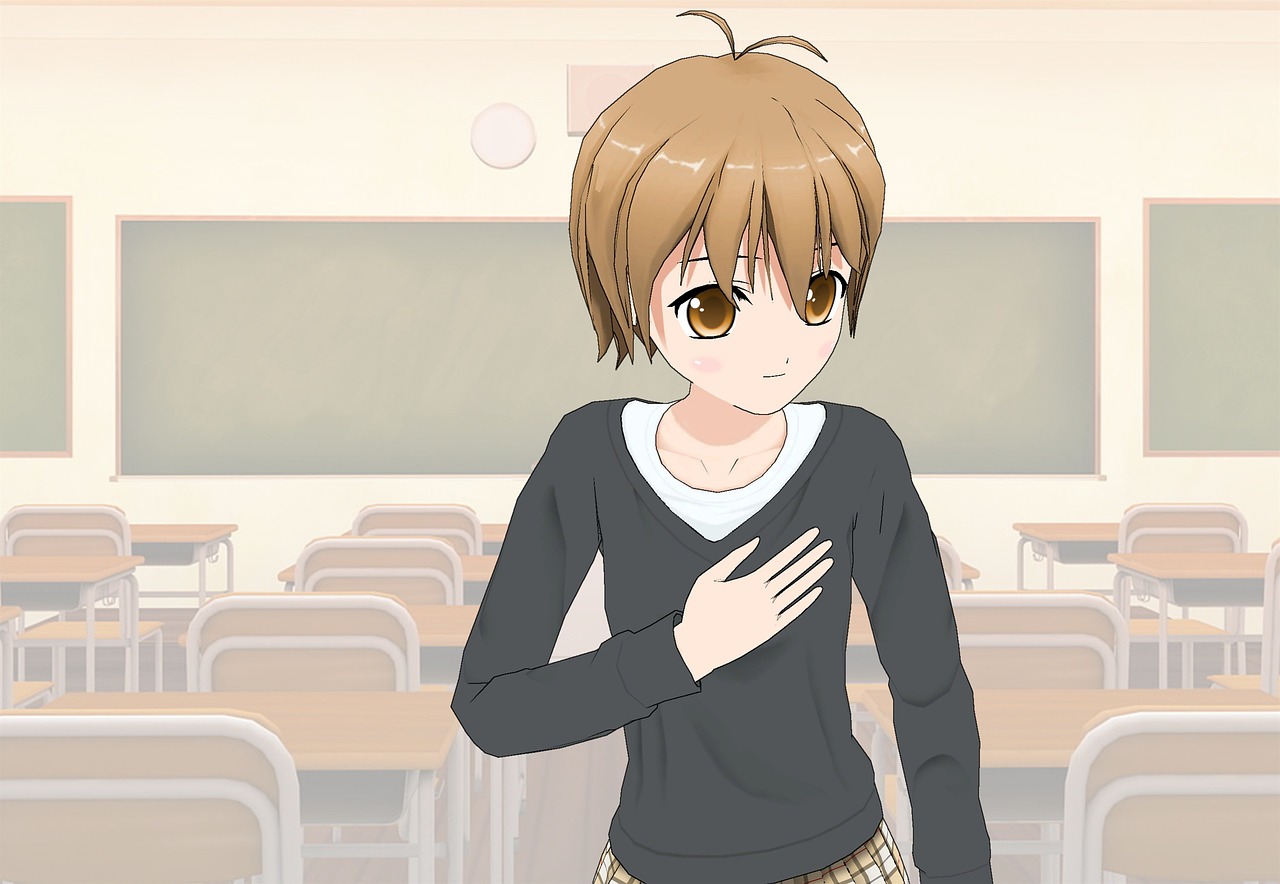"The Dreaming Boy is a Realist" is a captivating anime series that has quickly gained attention within the anime community. This series intertwines elements of dreams and reality, creating a narrative that is both imaginative and grounded. The story follows the protagonist, Wataru Sajou, a high school student who is in love with his classmate Aika Natsukawa. Despite his dreamy nature, Wataru is forced to confront the realities of his feelings and his relationships.
Set in a typical Japanese high school, the series explores the everyday lives of its characters while delving into their deeper emotions and aspirations. The backdrop of the school setting allows for a relatable and engaging storyline that resonates with a broad audience. The series skillfully balances humor and drama, providing a well-rounded viewing experience that appeals to fans of various genres.
Since its release, "The Dreaming Boy is a Realist" has received positive reviews for its fresh take on the high school romance genre. Critics and fans alike have praised its character development and the realistic portrayal of teenage emotions. The anime’s ability to blend the protagonist’s dreamy idealism with the harsh truths of reality has been highlighted as one of its strongest points.
The initial reception of the series has been overwhelmingly positive, with viewers appreciating the relatable characters and the realistic depiction of their struggles. The anime has sparked discussions online, with fans eagerly sharing their thoughts on the storyline and the character dynamics. This engagement has helped to build a strong community around the series, enhancing its impact on the anime landscape.
"The Dreaming Boy is a Realist" stands out for its thoughtful exploration of themes such as love, self-discovery, and the balance between dreams and reality. The series invites viewers to reflect on their own experiences and aspirations, making it a meaningful addition to the anime genre. As the series continues to develop, it promises to keep its audience engaged with its heartfelt storytelling and relatable characters.
For more information and updates on the series, visit the official website.
Contents
Plot Synopsis and Key Themes
 "The Dreaming Boy is a Realist" centers on Wataru Sajou, a high school student who harbors deep feelings for his classmate, Aika Natsukawa. Despite his dreamy and idealistic nature, Wataru faces the harsh realities of teenage love and the complexities of high school relationships. The series captures his internal struggle between his romantic fantasies and the pragmatic steps he must take to navigate his emotions and interactions.
"The Dreaming Boy is a Realist" centers on Wataru Sajou, a high school student who harbors deep feelings for his classmate, Aika Natsukawa. Despite his dreamy and idealistic nature, Wataru faces the harsh realities of teenage love and the complexities of high school relationships. The series captures his internal struggle between his romantic fantasies and the pragmatic steps he must take to navigate his emotions and interactions.
The story unfolds in a typical Japanese high school setting, providing a familiar backdrop for viewers. As Wataru grapples with his feelings for Aika, he is also surrounded by friends and classmates who add depth and variety to the narrative. These characters each have their own dreams and challenges, creating a rich tapestry of interwoven stories that explore the highs and lows of teenage life.
Key Themes:
- Reality versus Dreams: The central theme of the series is the tension between dreams and reality. Wataru’s journey is marked by his constant battle to reconcile his idealistic dreams with the pragmatic steps needed to make those dreams a reality. This theme resonates with viewers who have faced similar struggles in their own lives, making the story relatable and poignant.
- Personal Growth: Wataru’s evolution from a dreamy, idealistic boy to a more grounded and realistic individual is a key aspect of the series. This theme of personal growth is portrayed through his experiences and interactions with Aika and his friends. The series highlights the importance of self-awareness, resilience, and the courage to face reality head-on.
- Relationships: The dynamics between Wataru and Aika, as well as the interactions with other characters, form the emotional core of the series. The exploration of friendships, rivalries, and romantic interests adds layers of complexity to the narrative. These relationships are depicted with authenticity, capturing the nuanced and often tumultuous nature of teenage interactions.
Resonance with the Audience:
The themes of "The Dreaming Boy is a Realist" strike a chord with viewers, particularly those who appreciate stories that blend idealism with realism. The relatable characters and their genuine struggles make the series engaging and emotionally impactful. By exploring the balance between dreams and reality, the series offers a refreshing perspective on high school life and the journey of self-discovery.
The detailed portrayal of personal growth and the realistic depiction of relationships add depth to the narrative, enhancing the viewing experience. The series invites viewers to reflect on their own dreams and the steps they need to take to achieve them, making it not just a source of entertainment but also a source of inspiration.
For more information and updates on the series, visit the official website.
Character Development and Dynamics
 "The Dreaming Boy is a Realist" presents a compelling cast of characters whose development and interactions are central to the story’s appeal. This series intricately weaves the personal growth of its characters with the overall narrative, creating a rich and engaging experience for viewers.
"The Dreaming Boy is a Realist" presents a compelling cast of characters whose development and interactions are central to the story’s appeal. This series intricately weaves the personal growth of its characters with the overall narrative, creating a rich and engaging experience for viewers.
Main Characters and Their Evolution:
- Wataru Sajou: Wataru is the protagonist, a high school student who dreams big but often finds himself confronted by the realities of life. His character arc is one of significant growth, transitioning from an idealistic dreamer to someone who begins to understand the balance between dreams and reality. His experiences and the challenges he faces in pursuing his feelings for Aika Natsukawa push him towards self-discovery and maturity.
- Aika Natsukawa: Aika is the object of Wataru’s affections and plays a pivotal role in his journey. Initially seen as distant and unattainable, Aika’s character is gradually revealed to have her own complexities and struggles. Her interactions with Wataru help to humanize her character, showing that she too grapples with her feelings and the expectations placed upon her.
Character Relationships and Dynamics:
The relationships between characters in "The Dreaming Boy is a Realist" are central to driving the plot forward. These dynamics are portrayed with depth and realism, capturing the complexities of teenage interactions.
- Wataru and Aika: The evolving relationship between Wataru and Aika is at the heart of the series. Their interactions are marked by misunderstandings, unspoken feelings, and moments of genuine connection. As Wataru learns to navigate his feelings and become more realistic, Aika’s responses to him also change, adding layers of tension and growth to their dynamic.
- Friendships and Rivalries: Wataru’s relationships with his friends and classmates also play a crucial role in his development. Friendships provide support and insight, while rivalries and conflicts offer challenges that test Wataru’s resolve and push him to grow. These interactions are depicted with authenticity, reflecting the typical highs and lows of high school life.
Introduction to New Characters:
As the series progresses, new characters are introduced, each bringing their own unique contributions to the storyline. These additions help to expand the narrative and add fresh dynamics to the existing relationships.
- New Allies and Adversaries: New characters often serve as both allies and adversaries to Wataru, offering different perspectives and challenges. Their presence helps to keep the storyline dynamic and engaging, preventing it from becoming stagnant.
- Role in Story Development: Each new character is carefully integrated into the storyline, with their roles designed to complement and enhance the main narrative. Whether they provide support, present new challenges, or introduce subplots, these characters contribute to the overall depth and richness of the series.
Conclusion:
The character development and dynamics in "The Dreaming Boy is a Realist" are masterfully handled, providing a realistic and engaging portrayal of teenage life. The growth of the main characters, the complexities of their relationships, and the introduction of new characters all work together to create a narrative that is both relatable and compelling. This focus on character evolution and interaction is a significant part of what makes the series resonate so strongly with its audience.
For more information, visit the official website.
Visuals and Artistic Style
"The Dreaming Boy is a Realist" captivates audiences not only with its engaging storyline but also through its stunning visual and artistic presentation. This anime excels in delivering a visually appealing experience that enhances its narrative and draws viewers deeper into its world.
Artistic Style and Overall Visual Appeal
The artistic style of "The Dreaming Boy is a Realist" is a harmonious blend of detailed character designs and vibrant backgrounds. The characters are designed with meticulous attention to detail, reflecting their personalities and emotions effectively. The backgrounds are lush and immersive, often portraying everyday school life with a touch of dreamlike quality that complements the series' themes.
The use of color in the series is particularly noteworthy. The palette ranges from soft, pastel tones during calm, introspective moments to bright, vivid colors during more dynamic scenes. This contrast helps to highlight the emotional states of the characters and the atmosphere of each scene.
Animation Quality
The animation quality in "The Dreaming Boy is a Realist" is consistently high, contributing significantly to the storytelling. Fluid character movements and expressive facial animations ensure that viewers can easily connect with the characters and their experiences. The animators' skillful use of lighting and shading further enhances the depth and realism of the scenes.
One of the strengths of the series is its ability to seamlessly blend realistic and fantastical elements. While much of the story takes place in a typical high school setting, moments of fantasy and surrealism are interwoven, creating a unique visual experience that keeps viewers engaged.
Key Scenes and Artistic Techniques
Several key scenes stand out in "The Dreaming Boy is a Realist" for their exceptional visual execution. For instance, dream sequences are depicted with a surreal quality that contrasts sharply with the everyday reality of the characters. These scenes often use a softer focus and ethereal lighting to create a dreamlike atmosphere, effectively conveying the protagonist's inner thoughts and feelings.
The series also employs various artistic techniques to enhance its narrative. Flashbacks are often rendered in a different color scheme or with a softer focus to distinguish them from the present timeline. This visual cue helps viewers easily follow the story's progression and understand the character's past experiences and motivations.
Moreover, the use of close-up shots and dynamic camera angles during intense emotional moments adds to the impact of these scenes. The careful framing of characters' expressions and body language communicates their inner turmoil and growth, making these moments more poignant and relatable.
Conclusion
In summary, "The Dreaming Boy is a Realist" leverages its high-quality visuals and artistic style to create an immersive and emotionally resonant viewing experience. The combination of detailed character designs, vibrant backgrounds, and fluid animation brings the story to life, enhancing the narrative and making it more engaging for the audience. Whether through the use of color, lighting, or dynamic camera work, the visual elements of the series play a crucial role in its storytelling, making it a standout in the anime community.
For more information, visit the official website.
Audience Reception and Future Expectations
 "The Dreaming Boy is a Realist" has garnered a significant amount of attention and praise from both fans and critics alike. The series, known for its unique blend of realism and dreamlike sequences, has made a substantial impact on the anime community.
"The Dreaming Boy is a Realist" has garnered a significant amount of attention and praise from both fans and critics alike. The series, known for its unique blend of realism and dreamlike sequences, has made a substantial impact on the anime community.
Reception by Fans and Critics
Fans have responded positively to the series, praising its relatable characters, engaging storyline, and beautiful animation. Many viewers appreciate the protagonist's journey of balancing dreams and reality, a theme that resonates deeply with audiences of all ages. The character development and the dynamic between the main characters have also been highlighted as strong points of the series.
Critics have similarly acknowledged the series for its thoughtful narrative and artistic execution. Reviews often note the show's ability to weave complex emotional themes with everyday experiences, creating a tapestry that is both compelling and visually stunning. The balance between humor, drama, and the occasional fantasy element has been particularly well-received, marking "The Dreaming Boy is a Realist" as a standout in its genre.
Impact on the Anime Community
"The Dreaming Boy is a Realist" has had a noticeable impact on the anime community. Its exploration of reality versus dreams has sparked discussions among fans and critics, leading to a deeper appreciation of its themes and storytelling techniques. The series has also inspired fan art, discussions, and even cosplay, indicating its strong cultural presence and influence.
The anime's success has contributed to a growing trend in series that blend mundane realism with fantastical elements. This fusion creates a unique narrative space that appeals to a broad audience, further cementing the show's place in contemporary anime culture.
Predictions and Expectations for the Future
Looking ahead, there are high expectations for the continuation of "The Dreaming Boy is a Realist." Fans eagerly anticipate further development of the main storyline, particularly how the characters will continue to grow and face new challenges. The potential for deeper exploration of secondary characters and their backstories is also a point of interest, promising more rich and engaging content.
There is speculation about potential spin-offs or extended media, such as light novels or manga adaptations, which could expand the universe of "The Dreaming Boy is a Realist." Such extensions would allow fans to dive deeper into the world and its characters, satisfying the growing demand for more content.
Additionally, the series' success might pave the way for more anime that explore similar themes of realism intertwined with fantasy. The positive reception indicates a strong market for such narratives, encouraging creators to innovate within this genre.
Conclusion
In summary, "The Dreaming Boy is a Realist" has made a significant mark on the anime landscape, celebrated for its relatable themes, character depth, and visual excellence. As the series progresses, fans and critics alike look forward to seeing how the story unfolds and how it will continue to influence the genre. The anticipation for future episodes and potential expansions reflects the series' enduring appeal and its promising future.
For more information, visit the official website.



